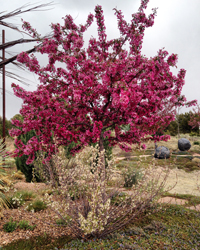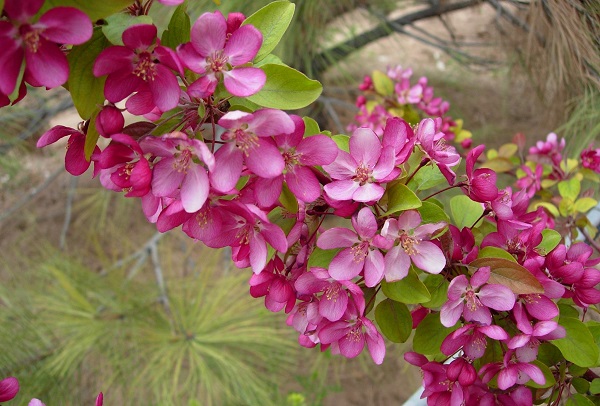Scientific Name: Malus × ‘Indian Magic’
Common name: ‘Indian Magic’ crabapple
Family: Rosaceae (rose)
Article by Susan Bruneni

‘Indian Magic’ crabapple (Photo by Cristina Salvador)
The plant collections of Santa Fe Botanical Garden at Museum Hill include two cultivars of ornamental crabapples: ‘Radiant’ (featured as the June 2015 Plant of the Month article) and ‘Indian Magic’. The cultivar Malus × ‘Indian Magic’ is one of the newer varieties of crabapple with stunning ornamental appeal throughout most of the year. Crabapples, known to the colonists as wild apples, were a ready-made food source while their planted orchards slowly matured. The genus is native to the temperate zone of the Northern Hemisphere.
Today there are several varieties bred for sweet fruit while others such as ‘Indian Magic’ are specifically bred for ornamental appeal. It is a small rounded tree 15-to-20-feet tall with upright spreading branches. Malus is a genus of about 30–55 species of small deciduous trees or shrubs in the family Rosaceae, including the domesticated orchard apple.

Photo by Tracy Neal
‘Indian Magic’ truly has multi-season appeal. Red buds in spring open into rose-pink flowers. They stay in bloom longer than other flowering trees, providing a pollination source. Green foliage in summer turns reddish orange in the fall. Then an abundant crop of small, bright red fruit appear and turn reddish-orange after the first few frosts. Fruit will stay on the tree well into the winter, providing a showy display and ample food for birds.
The small fruits are great for cooking because they are high in pectin. All crabapples are edible, although many species are too sour to eat raw. Some species do not produce fruit. Seeds do contain small amounts of toxins so it is advisable to prevent pets from eating large amounts of the whole fruit. Wildlife do not ingest the seeds.
Flowering crabapples grow best in well-drained, acidic loams, but adapt to a wide range of soils. Plant crabapple trees in full sun for best flowering. This tree requires a medium amount of water, but established trees have some drought tolerance. If needed, it is best to prune in late winter, as fresh, open cuts in spring are susceptible to fire blight, a disease caused by bacterium Erwinia amylovora.
In 2019, several trees of both crabapple cultivars in the plant collections began showing the characteristic symptoms of fire blight. The leaves had discoloration, wilting, and the branch terminals were thinning and looked as if they were scorched by fire. The trees and symptoms were photographed, reported to New Mexico State University Plant Diagnostic Clinic, and samples were sent to the lab for testing which confirmed the infection in the trees. Part of the disease management is removing one of the infected trees and pruning out infected tissue in the spring. We hope to continue the best horticultural practices to prevent further infection and reduce further losses. To learn more about workshops that teach pruning techniques and to attend our upcoming lecture on “Supporting Resilient Trees: Understanding current and emerging plant pathogens” visit our events calendar on our website.
References
“Crabapples (Apples) Malus species”. Plant Fact Sheet. USDA, NRCS, National Plant Data Center. Web. 17 Jan 2020. Retrieved from: https://plants.usda.gov/factsheet/pdf/fs_malus.pdf.
“‘Indian Magic’ crabapple”. Garden Explorer. Santa Fe Botanical Garden. Web. 17 Jan 2020. Retrieved from: https://santafebotanicalgarden.gardenexplorer.org/taxon-491.aspx.
“Malus ‘Indian Magic’”. Plant Finder. Missouri Botanical Garden. Web. 17 Jan 2020. Retrieved from: https://www.missouribotanicalgarden.org/PlantFinder/PlantFinderDetails.aspx?taxonid=249509.
“Malus ‘Indian Magic’”. The Royal Horticultural Society. Web. 17 Jan 2020. Retrieved from: https://www.rhs.org.uk/Plants/238789/i-Malus-i-Indian-Magic/Details.


